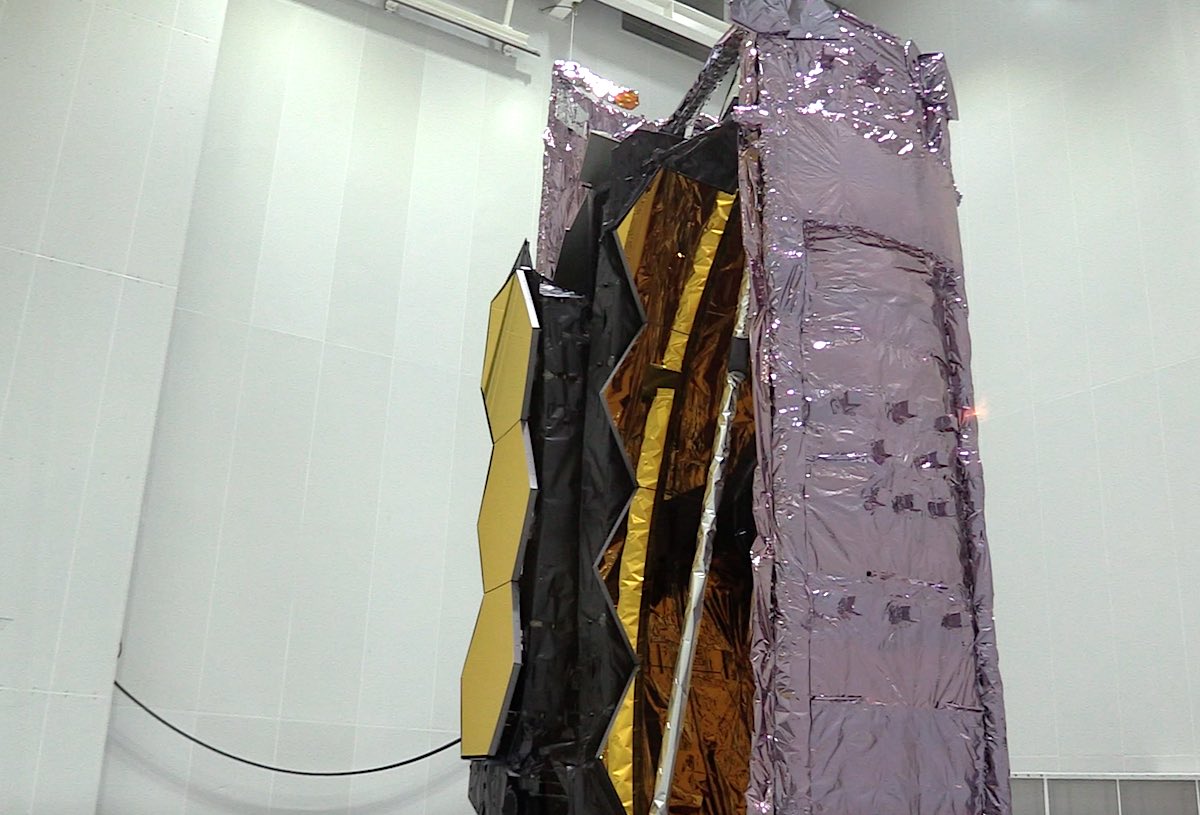
NASA engineers have cleared teams at the Guiana Space Center in South America to begin loading 63 gallons of fuel and oxidizer into the James Webb Space Telescope, after extra testing showed the observatory suffered no damage during a processing incident in the clean room earlier this month.
During a “consent to fuel” review held Wednesday, Nov. 24, mission managers gave approval to begin the propellant loading process at the French Guiana spaceport the following day.
“Additional testing was conducted this week to ensure the observatory’s health following an incident that occurred when the release of a clamp band caused a vibration throughout the observatory,” NASA said in a statement Wednesday.
The start of propellant loading keeps the $9.7 billion James Webb Space Telescope on track for liftoff Dec. 22 aboard a European Ariane 5 rocket. The half-hour launch window opens at 7:20 a.m. EST (1220 GMT; 9:20 a.m. French Guiana time).
The propellant loading operations inside the S5B fueling cell at the Guiana Space Center will take about 10 days to complete, according to NASA. The 10-day period includes steps to prepare, purge, and pressurize elements within the spacecraft bus, the lower section of the 35-foot-tall (10.66-meter) observatory.
The propellant loading itself will occur over several hours on two separate days, mission team members told Spaceflight Now.
The Webb telescope’s spacecraft bus, built by Northrop Grumman, will be filled with 42 gallons (159 liters) of hydrazine and 21 gallons (79.5 liters) of dinitrogen tetroxide, a mix of storable fuel and oxidizer to feed the mission’s 20 rocket thrusters, according to Mark Voyton, NASA’s launch site manager for Webb.
Four of the small engines — a primary and redundant thruster in two pods — will consume fuel and oxidizer for major course correction maneuvers. Webb has eight more thruster modules, each with two small hydrazine-fed engines to nudge the observatory with a single pound of thrust, providing pointing control in concert with spinning reaction wheels inside the spacecraft.
Ground teams wearing self-contained protective suits will be inside the clean room during loading of the toxic propellants. Technicians will also load helium pressurant into the spacecraft.
Webb’s spacecraft bus provides propulsion, electrical power, and communications for the observatory.
NASA announced last week that Webb’s launch was delayed from Dec. 18 to Dec. 22 after managers ordered additional testing on the spacecraft.
The space agency said a “sudden, unplanned release” of a clamp band sent a vibration through the observatory Nov. 9, when technicians were mating Webb to its launch vehicle adapter, a device that connects the observatory with the upper stage of the Ariane 5 rocket.
The adapter’s high-tension clamp band system secures the spacecraft to the rocket until the command to separate Webb about a half-hour after liftoff.
RUAG Space, a Swiss company that specializes in building rocket structures and other components, supplied the payload adapter system for the Ariane 5 rocket and Webb, according to posts on the company’s social media pages.
The processing work inside the S5 payload facility at the Guiana Space Center is being performed under the “overall responsibility” of Arianespace, the French launch services provider for the Ariane 5 program. The European Space Agency, a junior partner on Webb, is paying for the launch as part of its contribution to the mission.
Once fueled, Webb will be transferred to the final assembly building at the spaceport in French Guiana, where a crane will hoist the observatory on top of its Ariane 5 launcher.
The James Webb Space Telescope is folded up in launch configuration to fit inside the Ariane 5 rocket’s 17.7-foot-wide (5.4-meter) payload fairing. Once in space, the observatory will unfurl a power-generating solar panel and a high-gain communications antenna, then start a series of make-or-break deployments of its five-layer sunshield, which will open to the size of a tennis court.
Webb, designed to peer deeper into the cosmos than ever before, has 18 gold-coated beryllium mirror segments that will combine to create the largest telescope mirror ever sent into space, with a diameter of 21.3 feet (6.5 meters). Some of the mirrors are mounted on deployable wings that must fold into place to configure the telescope for science observations.
Then the telescope’s infrared detectors have to cool down to cryogenic temperatures, with parts of the instruments chilled to near absolute zero at a temperature of 7 Kelvin (minus 447.1 degrees Fahrenheit).
The telescope’s mirror segments each have tiny mechanical actuators to adjust focus and alignment. The design makes Webb the most expensive and most complex science mission ever launched into space.
“When you work on a $10 billion telescope, conservatism is the order of the day,” said Thomas Zurbuchen, head of NASA’s science mission directorate.
Email the author.
Follow Stephen Clark on Twitter: @StephenClark1.
